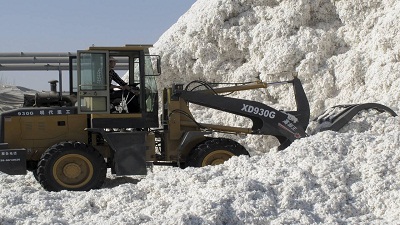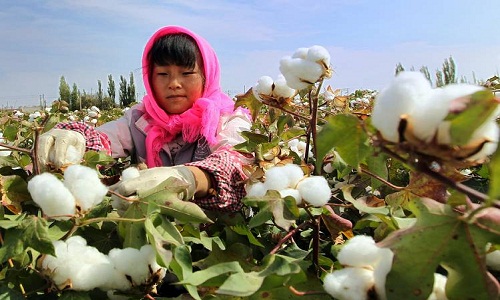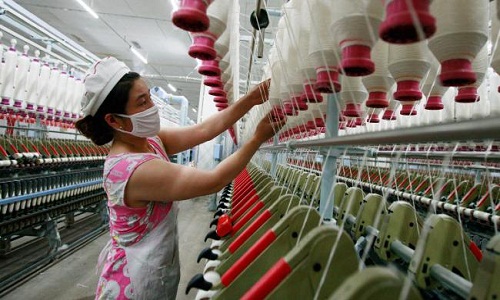FW
Cotton futures showed some recovery during the early part of the week but profit taking increased towards the latter half due to deepening concerns over slowing import demand from China.
China is likely to be the third largest cotton importer, behind Bangladesh and Vietnam. The country was the biggest importer globally a few years back. China is likely to import five million bales of cotton in the current season.
Net weekly export sales of upland cotton from USA fell by 10 per cent for the week ending February 4, comparing from the week before. The export volume however remains up by 22 per cent from the prior four-week average. Increases were reported for Turkey, Colombia, Vietnam, China, Bangladesh and Taiwan.
Though prices can remain weak in the coming days, worsening concerns over lower production and tightening of arrivals in spot market will be restricting the bearish movements in the near term. Plunging cotton prices have turned supportive for active buying in the spot market, which will be positive for the futures market as well.
India’s cotton production forecasts have been reduced 7.4 per cent against the previous year’s production. Cotton arrivals are lagging by almost 30 per cent compared to the previous year. The reason is that farmers are holding cotton in anticipation of higher prices.
This year China will aim at stimulating growth and encouraging restructuring of industries afflicted with overcapacity.
For the first time in two decades, China has adopted a range for its growth target rather than a specific number, giving itself more flexibility in a system where hitting stated goals remains politically important. Growth over the next five years is expected to average at least 6.5 per cent.
The country will address the issue of zombie enterprises proactively yet prudently by using measures such as mergers, reorganisations, debt restructuring and bankruptcy liquidations. Zombie enterprises are unproductive businesses kept alive by debt and subsidies.
About 10 million jobs would be generated in urban areas and unemployment would be kept below 4.5 per cent in cities. Among the job creation initiatives are railway construction and road building.
To leave room for more spending, the targeted budget deficit will be three per cent of gross domestic product this year, up from 2.3 per cent in 2015.
China also plans to raise military spending in 2016 by 7.6 per cent. This would be the slowest pace in six years, but still larger in percentage terms than the seven per cent increase for the overall budget, suggesting the military still gets an outsize share of government resources.
Brazilian cotton prices dropped during February while the downtrend was more intense in the last week of the month. Prices were pushed down due to higher supply and weak demand and as trading companies were quoting prices lower than those asked by cotton farmers.
Even though some producers remained firm in asking prices, others were waiting for prices to increase.
Cotton brokers and merchant were active, but the gap between asking and quoted prices hampered new trades, especially for the second fortnight of the month.
This in turn led to textile mills purchasing in small batches.
The monthly average was 1.66 per cent lower than in January 2016 but still 37.2 per cent higher than in February 2015.
Brazil is one of the world’s leading cotton producers. Thanks to various economic and technological interventions – such as targeted government support, the emergence of new cotton producing regions, and precision farming technologies – Brazil’s cotton production is thriving. The country is one of the world’s largest consumers of cotton fiber as well.
In Brazil, cotton is sown from February to March and harvested from September to December.
Farmers in Brazil have taken the lead in development and conservation of soil. For them conservation of soil is a long drawn system and not a one-time application.
Blended yarn exports of India declined four per cent in January largely due to a fall in prices.
India is a major producer, consumer and exporter of 100 per cent cotton yarns as well as blended yarns. The major types of blended yarns exported from India are polyester/cotton and polyester/viscose yarns. Other major blend yarn types exported are cotton/viscose, acrylic/cotton, poly/acrylic, poly/wool etc. Most of the blended yarns produced are binary yarns (two component yarns).
The blended fabric market in India has grown at a CAGR of 10.1 per cent. The share of blended fabrics is around 15 per cent of total fabric production.
It is expected that the demand for blend yarn will outpace the demand for cotton yarn in the near future.
Tertiary yarns are also produced to some extent. Though 100 per cent cotton yarns dominate the spun yarn market, the production of blended yarns is on the rise.
In China, imports of yarn have fallen as domestic prices were down due to falling cotton prices. However, PSF and VSF prices were firming up as yarn makers resumed operation. Blended yarn prices generally rolled over.
Yarn suppliers in Pakistan resisted any decline in yarn prices to maintain margins at low levels. Polyester-cotton blended yarn prices of 24s and 31s counts were however, under pressure.
The Alliance for Bangladesh Worker Safety, the North American retailers’ group has cut business relations with five more readymade garment factories (RMG) based in Dhaka and Chittagong citing that the factory authorities have failed to make their establishments safer for their workers.
According to the Alliance for Bangladesh Worker Safety, relations with four factories have been suspended due to their failure in complying with government-set review panel’s recommendations. The Alliance cut relations with another one due to its failure in making adequate remediation progress.
The suspended five factories are: AMC Sweater in Gazipur, Darda Knit Wears at Ashulia and Maggie and Liz Corporation (PVT), Maks Fashion and Montex Apparels in Chittagong. So far, the total number of the suspended supplier factories by the Alliance reached to 31.
After the Rana Plaza building collapse, which killed more than 1,100 people, mostly garment workers, in April 2013, North American retailers, including top brands Walmart and Gap, formed the Alliance and European retailers formed the Accord on Fire and Building Safety in Bangladesh undertaking a five-year plan which set timelines and accountability for inspections and training and workers’ empowerment programmes. The Alliance has so far inspected 870 factories while the Accord inspected more than 1,600 supplier factories.

With global cotton prices have plunged in recent weeks, the speculation mounts that China is getting ready to sell some of its 11 million-metric-ton stockpile - enough to make 10 billion pairs of jeans.
According to commodity analysts, China is expected to conduct a cotton auction in the next few months, its first since the end of August. While the government sells nearly all of its cotton at home, it is such a big player in the market that unloading a chunk would depress global prices by reducing how much foreign cotton Chinese businesses buy. China holds about 60 per cent of the world’s cotton stockpiles and is responsible for slightly less than a third of global consumption.
Import restrictions

In addition to this, the Chinese government has tightened import quotas for cotton, leading to less global access to that market and a 41 per cent drop in imports in January from a year earlier.
The expectation of a new round of selling by China has pushed down prices on the Zhengzhou Commodity Exchange to their lowest levels since 2004. Meanwhile, the benchmark ICE Futures U.S. exchange has cotton trading near its lowest since 2009, dropping about 12 per cent since the beginning of the year; the May contract settled at 56.41 cents a pound recently.
According to Paul Deane, agricultural commodity analyst at Australia & New Zealand Banking Group, until those Chinese stocks are cleared, it is going to be hard for cotton to break away from current levels, which is bearish on cotton.
Aggressive measures
Meanwhile, the China National Cotton Exchange said it hadn’t been notified of further auctions from the National Development and Reform Commission. The commission was unavailable for comment. However, the U.S. Agriculture Department said there are numerous unofficial indications that the Chinese government intends to pursue a more aggressive reserve stocks-sale programme in the spring and summer of 2016.
During the last year’s July-to-August auction, the National Development and Reform Commission had wanted to sell one million tons of cotton, but fell far short; selling only 63,413 tons, because the price being asked was higher that what most were willing to pay. Global prices have dropped 9.5 per cent since then.
However, much it sells at its next auction, China will lose money. According to the USDA, it bought cotton for the equivalent of $2,950 to $3,200 a ton during a period when the median monthly global price was $2,000 a ton. China sold some of these stocks for an average equivalent price of $2,175 a ton in last year’s auction - a loss of at least 26 per cent on its original investment.
Selling at a lower price

According to a Commonwealth Bank of Australia statement, China will need to set prices lower to sell its stockpiled cotton, bringing it more in line with depressed global prices. If it does sell at lower prices, the USDA predicts China may be able to cut its reserves 13 per cent by July 31 of next year.
One factor putting pressure on China to sell is that cotton deteriorates, so it can’t simply hold supplies for years in hopes the price will rise. The stockpile dates back to a government program introduced in March 2011 to improve the livelihoods of domestic cotton farmers by setting a floor for prices. But with global cotton prices dropping, China chose to store the cotton rather than sell it on the global market.
According to the USDA, the result was a doubling of the world’s stockpiles, which further depressed prices. USDA estimates of cotton stockpiles are slightly above China’s. Said Nick Hungate, global head of cotton at RCMA Commodities Asia Pte, that some of it has certainly deteriorated over time. He said markets have speculated that much of the higher-quality cotton has already been sold and what is left is the lower-grade cotton. China has since ended the price-support program for cotton.
Nishiki is the art of traditional silk weaving in Japan.Nishiki represents the pinnacle of silk as a work of art. It has always been highly revered by the Japanese people and a great source of national pride.
Nishiki is woven on takabata looms. The high precision and skill level required to weave this fabric and the resulting extraordinary beauty and quality demands that it be distinguished from ordinary brocade by giving it a distinctive name, Nishiki.
In the Japanese language, the idiographic character used for Nishiki is a combination of the symbol for woven cloth combined with the symbol for gold, implying that the value of Nishiki is equal to that of money. Nishiki is created through the combined skills of numerous craftsmen, involving a broad range of technical processes that require time and patience.
As the silk threads, each shining like gold, combine with one another, they come to harmonise as a brilliantly colored, dazzling, sublimely created Nishiki creation.
The superb visual-textural feeling of silk’s infinite variations and hues, enhanced through processes cultivated over a millennium, is translated into works of art.
One of the main defining characteristics of Nishiki is that it is woven in layers, creating a three-dimensional effect. The individual translucent silk threads are like glass rods with a slightly rounded, triangular prism shape.
Planet Textiles conference and exhibition reveals the first speakers of a uniquely diverse and influential line-up for four days of textile sustainability events in Denmark in May. Sandwiched between the two-day annual member meeting of the Sustainable Apparel Coalition and the Copenhagen Fashion Summit, Planet Textiles will feature renowned environmentalist, mountaineer and filmmaker, Rick Ridgeway, Patagonia's vice president of environmental affairs. Ridgeway is joined by a high profile cast which includes organisations such as the Chinese National Textile and Apparel Council (CNTAC) which has chosen Planet Textiles to make its first presentation in the European textile market on the new 5-year plan – and how this plan will impact environmental issues in China's textile manufacturing sector to 2020.
Among the other confirmed speakers include senior governmental representation from the German Ministry's Partnership for Sustainable Textiles; the European Clothing Action Plan, which will talk about how to embed a circular economy approach to the European clothing sector; along with initiatives from other leading clothing and retail brands such as VF Corporation – which produces 562 million units of clothing per year from over 30 of its brands, including The North Face, Wrangler, Lee, Timberland and Volcom - to name a few.
Orissa plans to set up an integrated textile park in Bhadrak district with an investment of Rs 70 crores to give a fillip to the textile sector. The proposed park will be developed over 112 acres of land. It is expected to house about 22 apparel manufacturing units.
The integrated textile park scheme launched in 2005 was aimed to encourage private investments and employment generation in the textile sector by facilitating world class infrastructure for common facilities, such as roads, water supply treatment and distribution network, power generation and distribution network, effluent collection treatment and disposal system, design centre, warehouse, first aid centre, etc.
The project cost under the scheme will be funded through a mix of equity or grant from the ministry. The government of India’s support will be limited to 40 per cent of the project cost with a maximum ceiling of Rs 40 crores for parks.
The scheme targets industrial clusters with high growth potential, which require strategic interventions by way of providing world-class infrastructure support. The project cost will cover common infrastructure and buildings for production and support activities depending on the needs of the integrated textile park.
Odisha Industrial Infrastructure Development Corporation is the land acquisition arm of the state.
Assuming Sri Lanka is given back GSP Plus benefits by the European Union, these will be for a maximum of seven years. That’s because Sri Lanka is expected to reach upper middle income country status by end 2016 and GSP Plus benefits don’t apply to this category of countries.
If Sri Lanka reaches the upper middle income country status, and maintains this status for three consecutive years, the country will only be given one more year by the EU before these trade concessions are withdrawn.
Once Sri Lanka is capable of maintaining the required per capita income level the EU would then give one more year for local industries to adjust before withdrawing the trade benefits.
The categorisation of Sri Lanka in the upper middle income country category, even if it happens this year, would take place in two or three years. This would mean that Sri Lanka could enjoy the trade concessions for just seven years if GSP Plus could be re-gained this year.
Sri Lanka enjoyed the EU trade benefits of GSP Plus in 2005 and lost them in 2010 after the country came under the hammer from the EU bloc for violating human rights, among other issues.












